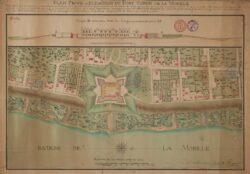Pierre Sidrac Dugué de Boisbriand
Canadian explorer Pierre Sidrac Dugué de Boisbriand, one of the founding fathers of colonial Louisiana, served as acting governor of Louisiana between February 1725 and March 1727.

Archives nationales d’outre-mer, Aix-en-Provence, France
Prior to assuming the governorship in 1725, Boisbriand was commandant at Mobile. This 1725 map by Adrien de Pauger shows plans for a new fort planned for the Mobile settlement.
Canadian explorer Pierre Dugué, one of the founding fathers of colonial Louisiana, served as acting governor of Louisiana between February 1725 and March 1727. He was ordered to replace Jean-Baptise Le Moyne, Sieur de Bienville, when Bienville was recalled to France. Before serving as governor, Dugué commanded Mobile for twelve years, where he helped solidify French control of the region. He also served as commandant of the Illinois district and supervised the building of Fort de Chartres on the banks of the Mississippi River in present-day Illinois.
Pierre Dugué, Sieur de Boisbriand (or Boisbriant) was born in Montreal, Canada, on February 21, 1675. The son of Michel-Sidrac Dugué, a Canadian seigneur, and Marie Moyen, he joined the French navy in 1691 and rose to the rank of ensign in 1694. In 1697, Dugué accompanied Pierre Le Moyne d’Iberville in the conquest of Fort Bourbon on the Hudson Bay. Two years later, Iberville recruited Dugué for his second expedition to Louisiana. They eventually landed in Mobile where Dugué remained for about twelve years. During that time, he became aide-major to Bienville and made a trip to Pensacola to borrow supplies from the Spanish in 1703. In 1705 he was badly wounded while accompanying a group of Chickasaw Indians through hostile Choctaw territory; he returned to Mobile on a stretcher. Early educator Marie-Françoise de Boisrenaud nursed him back to health and the two wanted to be married; Bienville prohibited it, however, because he felt she was too closely allied to Nicolas La Salle, one of Bienville’s political enemies.
Shortly before sailing to France in 1717, Dugué was appointed commandant of the Mobile and Dauphin Island district. In France he used his time to settle personal business affairs and lobby French officials in support of Bienville. On his return to Louisiana, Dugué was named commandant of the Illinois district on April 17, 1718, where he supervised the building of Fort de Chartres. When Bienville was recalled to France in late 1724 amidst charges of corruption and mismanagement, Dugué was named acting governor, a position he held until the arrival of Etienne de Periér on March 15, 1727.
With Periér’s arrival, Dugué fell out of favor with French officials, in part because of his close ties to Bienville. Dugué left New Orleans for France in November 1728. On his arrival, he suffered censure and was dismissed from the royal service, though he was belatedly awarded a modest pension in 1730. He lived long enough to see Bienville reappointed as governor in 1733, but died in France on June 7, 1736.
Adapted from Brian E. Coutts’s entry for the Dictionary of Louisiana Biography, a publication of the Louisiana Historical Association in cooperation with the Center for Louisiana Studies at the University of Louisiana, Lafayette.
Sources: Jay Higginbotham, Old Mobile: Fort Louis de la Louisiane, 1702-1711 (1977); Marcel Giraud, Histoire de la Louisiane française, 4 vols. (1953-1974); A. Krebs, “Pierre Sidrac du Gué de Boisbriant,” Dictionnaire de Biographie française, XI; W. Stanford Reid, “Pierre Dugué de Boisbriand,” Dictionary of Canadian Biography, II (1969); Dunbar Rowland and Albert G. Sanders, eds., Mississippi Provincial Archives: French Dominion (1927-1932), I-III.
